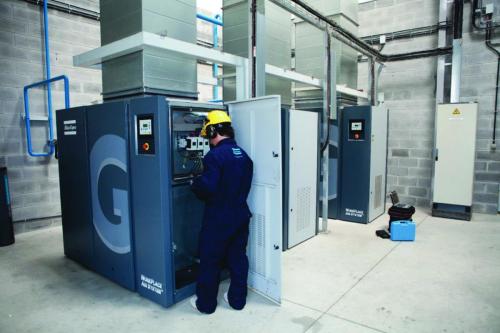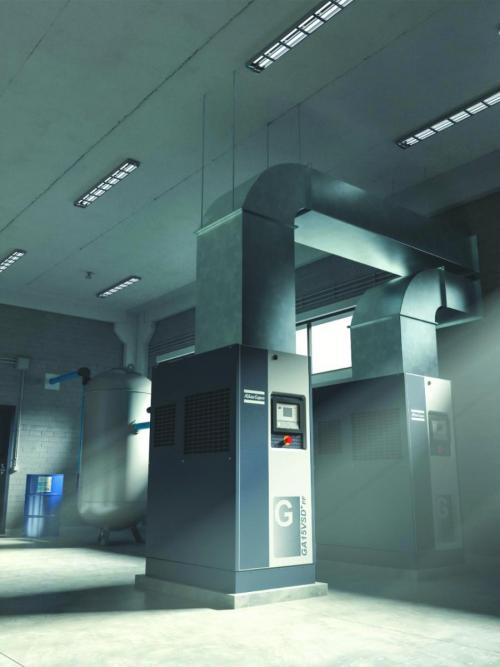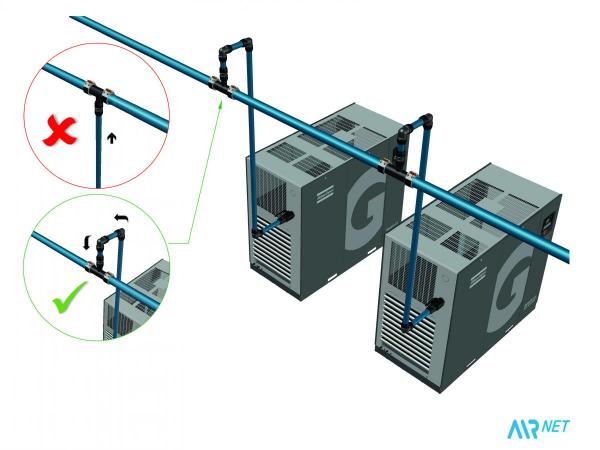While we cannot always create an ideal installation due to budget, floor space or time restrictions, it’s worthwhile to review some best practices for installing a compressor in a new plant or making improvements to your existing system.
Air Compressor Room Design
Location
Creating a designated compressor room allows for better control of the compressor’s air quality in addition to ensuring the compressors are kept at the proper temperature through the use of HVAC or ventilation. While current compressors have been engineered to be much quieter than previous models, they can still produce a significant amount of noise. Placing compressed air equipment in a designated room helps to significantly reduce noise levels in employee work areas.
Ideally, your compressor room should be located as close to its point of use as possible. Most companies try to locate the compressor room in a centralized location to minimize the distance air must travel to reach all of its processes. This also helps minimize the amount of compressed air piping, pressure drop and potential leak points.
Within the compressor room, it’s important to position compressors and equipment with enough space around the machines for proper ventilation. If the equipment is too close together, hot air from one compressor may be drawn into the compressor sitting next to it.
Clearance
Always consult your compressed air manufacturer for proper clearance required in cooling and equipment maintenance. For example, compressors with canopies may have doors swinging on hinges or doors needing to be completely removed. Each of these options will require a different type of clearance. Another example takes into consideration large maintenance issues, requiring the use of larger tools such as hoists or jacking equipment. These special circumstances need enough clearance height and floor space for maintenance personnel to access the machines.
Condensate disposal
Because condensate contains concentrated contaminants from compressed air and oil-injected equipment, it should never be drained into the sewer without first separating or filtering the contaminants from the water. Remember to follow local regulations for waste disposal of condensate from compressors, after coolers, dryers and air receivers.
Outdoor installations
Depending on the climate or location of the installation, it may be possible to install the compressed air system outside. The equipment should be installed under a lean-to or roof to prevent rain from leaking into its electrical cabinet. Compressors can also draw in water due to its high quantity of air intake. Therefore, the inlet side of the compressor should not be too close to the edge of the roof. If improperly placed, the compressor will ingest water and sustain serious damage. A minimum of NEMA 3R enclosures, protecting the equipment from falling water and dirt, should be specified. Higher ratings such as NEMA 4 are required if the customer intends to pressure wash the compressors.

Figure 1: Servicing the air compressor.
Air Compressor Room Ventilation
Overheating vs. freezing temperatures
One of the leading causes of compressor shutdowns is due to overheating from inadequate compressor room ventilation, particularly with air-cooled compressors. An ambient temperature of 40 – 100°F should be maintained at all times to keep compressors running properly. Compressor after coolers are typically designed to cool compressed air to a temperature of “ambient +15° F.” The higher the temperature rises, the more likely it is for the compressor to fault out with a high temperature alarm and for dryer performance to suffer. The compressed air supply will then contain more moisture, negatively affecting industrial processes.
Conversely, if compressor room temperatures drop below freezing, condensate lines can freeze and cause ice to form in the in the after cooler, discharge line or dryer. As ice forms, it will expand and potentially damage any of these components. Cold temperatures will also increase coolant viscosity, requiring the motor to use more power to turn the airend. In turn, it will drive up energy and maintenance costs due to the malfunctioning of the motor and bearings.
Compressed Air Purification & Piping Monthly e-NewsletterWith a focus on Demand-Side Optimization, compressed air dryers, filters, condensate management, tanks, piping and pneumatic technologies are profiled. How to ensure system reliability, while reducing pressure drop and demand, is explored through System Assessment case studies. |
Compressor room temperature management
Air compressors generate a tremendous amount of heat. This heat must be properly managed to avoid shutdowns and equipment damage. For example, a rotary screw compressor will produce approximately 3000 BTU/hr of heat energy per horsepower. Ideally, the installation will use this heat energy as an extra heat source in cold weather months or to heat water for an application. If the heat is unable to be reused then proper ventilation is critical.
Ventilation air should be drawn from the exterior of the compressor room at the lowest and coolest possible point on one of the room’s walls. On the opposite wall, temperature-controlled ventilation fans should be installed at the highest point of this wall.
Cool air needs to flow across all of the equipment in the room. This is why it is critical to have intake and exhaust ducts on opposite walls. One of the most common reasons for compressor shutdowns is due to high temperatures, typically occurring when there is insufficient ventilation. A good rule of thumb – if the room is too hot for employees to work then it’s too hot for compressors as well.
Ducting
If the design of the compressor room makes it too difficult for cooling air to flow across the compressor then ducting is the best alternative. You have the option of ducting both the inlet and outlet air, or just one, depending on your current setup. Make sure to review the manufacturer’s specifications on airflow and how to size your ventilation ducting in order to keep backpressure at a minimum. Most cooling fans are not designed to work effectively with more than 1/10 psi of backpressure.
Intake air
For trouble-free, efficient operation, compressor intake air must be free of all solid and gaseous contamination. Dirt, dust and corrosive gases cause premature wear. They can also negatively react with the compressor coolant, causing damage to the oil system and airend. Areas with high dust content should utilize a pre-filter in the installation.
Remember, any gas or fumes ingested by the compressor will eventually end up in the process air at much higher concentrations, contaminating everything from breathing air to your facility’s end products.

Figure 2: Ducting heat from a pair of compressors
Piping Design
Pipe sizing
Properly piping compressors to the header is extremely important especially because improperly piped air compressors can cause leaks, pressure drops or machine failure. If the piping is too small than the velocity of the air will increase. Increased velocity causes increased turbulence in valves and tees making it harder to accurately perform pressure readings.
We’ll walk through an example to demonstrate the serious effects – pressure drop and efficiency – the diameter and length of piping can have on the compressor system.
Say we have a 25 hp compressor producing 100 cfm at 100 psi. Moving up from a 1” pipe to a 1.5” inch pipe will significantly reduce the pressure drop and save the customer between 1 to 1.5 percent on their energy bill. In addition to proper pipe sizing, minimizing elbows, tees and quick disconnect fittings all help to reduce pressure drop and potential leak points, saving users time and money.
Designing Piping Systems for Low Pressure Drop - Webinar RecordingDownload the slides and watch the recording of the FREE webcast to learn:
|
Piping layout
Piping layout is just as important as the pipe’s diameter in optimizing airflow and reducing potential problems. In any system design with multiple drops, equalizing pressure throughout the entire plant is critical for stable use and measurement. Using a single piping run along with multiple airdrops will cause users at the end of the line to receive a significant reduction in airflow. In addition, pressure transducers installed in the system may improperly read varying pressures depending on where they are located. To combat these issues, users should create a layout of their piping in a ring, forcing evenly distributed airflow throughout the entire plant.
Compressor plumbing
Finally, the compressed air may contain small amounts of water having condensed in the piping. To eliminate the possibility for this water to drain back down into the compressor, the supply line should always be plumbed into the top of the header. This will prevent water or contaminants from draining down into another currently stopped compressor.

Figure 3: Proper connection to piping header
In an ideal world, we would all have plenty of space, time and money to create the perfect compressed air system. Unfortunately, this is rarely the case. In practice, we have to balance our ideals versus what we can actually accomplish. Compressed air systems take considerable forethought and planning to achieve a perfect install; however, we can use some key takeaways from this article even if we are ever faced a less than ideal installation. Remember to keep the compressors cool, minimize piping pressure drop and to allow sufficient room around the equipment for service.
For more information, visit www.atlascopco.com/en-us.
To read similar articles on Compressed Air System Assessments, please visit www.airbestpractices.com/system-assessments.




